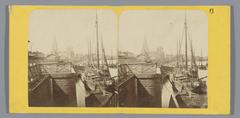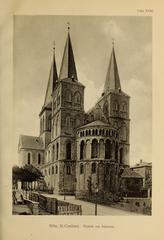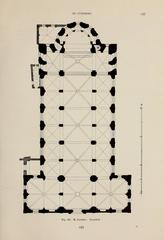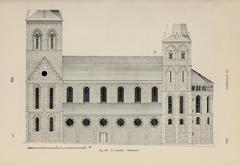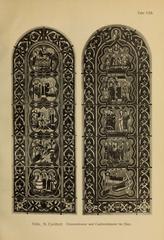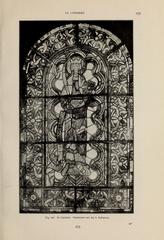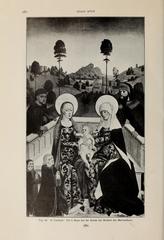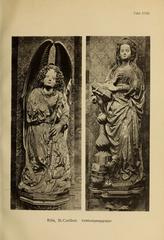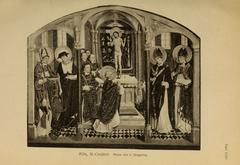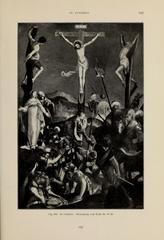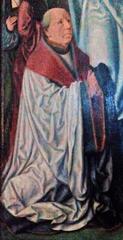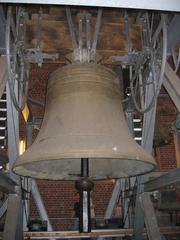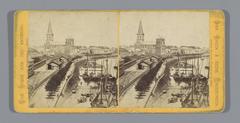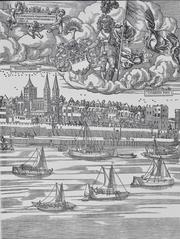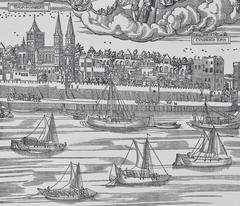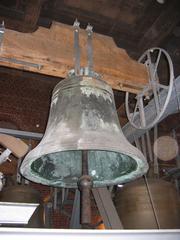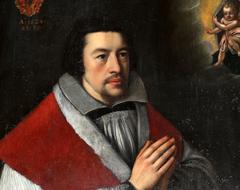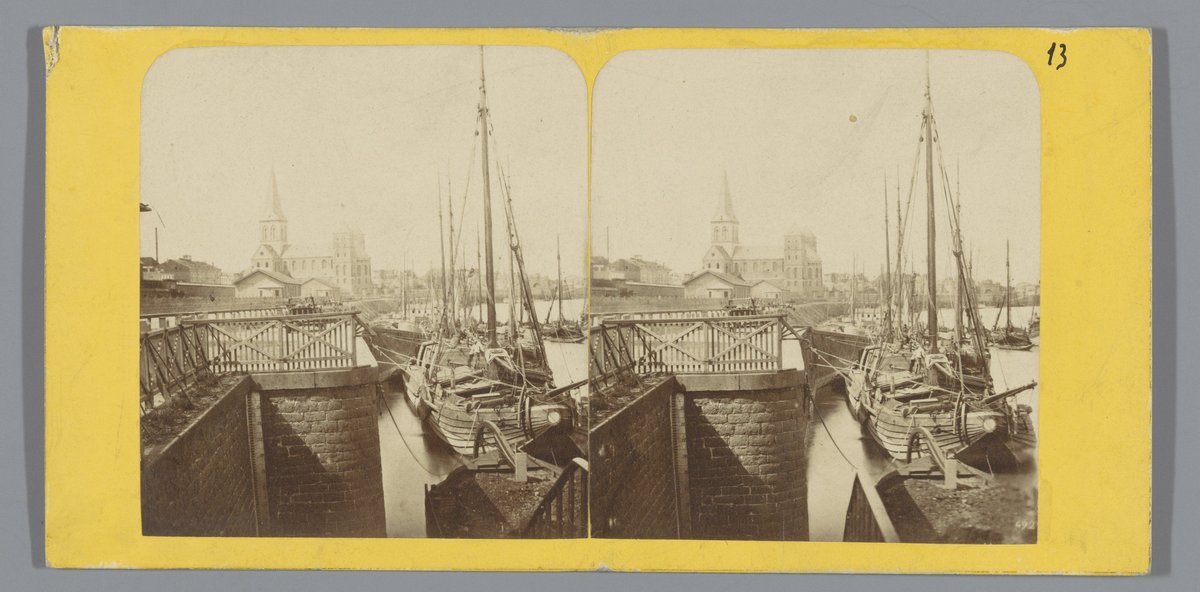
St. Kunibert Church Cologne: Visiting Hours, Tickets, and Travel Guide
Date: 14/06/2025
Introduction
St. Kunibert’s Church in Cologne is an essential destination for anyone seeking to experience the city’s medieval heritage and architectural grandeur. As the youngest of Cologne’s twelve Romanesque churches, it stands out for its harmonious blend of Romanesque and early Gothic styles, its treasured medieval stained glass, and its deep-rooted significance as a center of pilgrimage and community life. This detailed guide provides all the information you need for a memorable visit, including opening hours, ticket details, accessibility, historical background, nearby attractions, and practical visitor tips.
For more detailed information, consult the official Cologne tourism page and historical resources (Wikipedia: St. Kunibert (Köln), Cologne Tourism, New Liturgical Movement).
Historical Background
Early Foundations and the Legacy of St. Kunibert
The roots of St. Kunibert’s Church trace back to the 7th century and the influential figure of Kunibert, Bishop of Cologne and advisor to Frankish royalty. Tradition holds that Kunibert founded a church here, originally dedicated to St. Clement, and was himself buried on the site in 663 CE. Over the centuries, his tomb became an important site of veneration, and the church soon bore his name (Wikipedia: St. Kunibert (Köln), The History of Cologne).
The church also became the burial site of the Two Ewalds, early Anglo-Saxon missionaries. Their relics, revered and wrapped in the historic Ewaldi-Decke, further enhanced St. Kunibert’s status as a pilgrimage destination (Katholisch in Köln).
Romanesque Construction and Artistic Heritage
The current Romanesque basilica, begun in the early 13th century under the leadership of Theoderich von Wied, was consecrated in 1247. This major reconstruction addressed both the growing congregation and the technical challenges of the church’s riverside location, resulting in a substantial crypt and a harmonious three-aisled basilica (Wikipedia: St. Kunibert (Köln), baukunst-nrw.de).
St. Kunibert’s architectural features include:
- A three-tower silhouette: Central western tower and two eastern transept towers
- Slender exterior walls and a two-story apse with a dwarf gallery
- Rib-vaulted nave with three double bays, reflecting late-Staufian Romanesque architecture
- 13th-century stained glass windows, among the oldest in Cologne, depicting biblical scenes and saints
The crypt, historically used for relics and burials, is also home to the “Kunibertspütz,” an ancient well associated with fertility legends (Fabrizio Musacchio, andreacefalo.com).
War Damage and Restoration
St. Kunibert sustained severe damage during World War II, particularly to its western transept and tower. Thanks to the preemptive removal of key artworks and glass, many treasures survived. Restoration efforts, completed in stages through the late 20th century, carefully balanced the preservation of medieval features with necessary modern interventions (Wikipedia: St. Kunibert (Köln)).
Visiting St. Kunibert Church: Hours, Tickets, and Accessibility
Opening Hours
- Monday to Saturday: 9:00 AM – 6:00 PM
- Sunday and Public Holidays: 12:00 PM – 6:00 PM
Hours may vary for services or special events. Check the official parish website for current information.
Admission
- Free entry for all visitors
- Donations are welcome to support ongoing preservation and community programs
Guided Tours
- Guided tours are available by advance arrangement through the parish office or Cologne tourism services
- Self-guided brochures in German and English are usually available at the entrance
- For an immersive experience, download the Audiala app for a detailed audio guide
Accessibility
- Wheelchair accessible: Ramps at the main entrance, accessible nave, and restrooms nearby (at Cologne Central Station)
- Some chapels and the crypt may have limited access due to historic design
- Portable ramp and assistance can be provided on request
Architectural and Artistic Highlights
- Romanesque Style: Rounded arches, symmetrical layout, robust towers
- Three-Tower Façade: Unique in Cologne, providing striking views along the Rhine
- Vaulted Ceilings: Ribbed vaults in nave and choir, enhancing acoustics and structural beauty
- Medieval Glass Windows: 13th-century stained glass in the choir, celebrated for their color and iconography
- Artistic Treasures:
- Late 15th-century bronze candelabrum
- Panel paintings including the Mass of St. Gregory
- Resurrection altarpiece by Bartholomäus Bruyn the Elder
- Modern works by Elmar Hillebrand (e.g., doors, crucifix)
- Crypt: Houses relics of St. Kunibert and the historic well
Community, Pilgrimage, and Events
St. Kunibert’s Church remains an active parish with regular Masses, special liturgical celebrations, and a vibrant musical life, including organ concerts and choral performances (Katholisch in Köln). The church is also home to the Kölner Kevelaer-Bruderschaft, a lay brotherhood organizing pilgrimages (Katholisch in Köln). The crypt’s Kunibertspütz well, though now closed to the public, is central to local fertility traditions.
Visitor Information and Practical Tips
Location
- Address: Kunibertskloster 2, 50668 Cologne, Germany
- Near Cologne Central Station (Köln Hauptbahnhof): ~600 meters/7–10 minute walk
- Public transport: Close to Ebertplatz and Breslauer Platz stops
Dress Code and Etiquette
- Modest attire is expected (cover shoulders and knees)
- Remain quiet, especially during services
- Photography without flash is generally permitted, but not during Mass; tripods require permission
Best Times to Visit
- Weekday mornings or late afternoons for quieter experience
- Spring and autumn offer pleasant ambiance
- Major festivals (Easter, Christmas) feature beautiful decorations but larger crowds
Safety
Cologne’s Old Town is safe, but exercise usual caution against pickpocketing in crowded areas.
Amenities
- No dedicated gift shop, but postcards and brochures may be available
- Cafés, bakeries, and traditional Kölsch beer halls nearby
Nearby Attractions
- Cologne Cathedral (Kölner Dom): UNESCO World Heritage, 10-minute walk south (Cologne Cathedral Visitor Info)
- Rhine River Promenade: Perfect for strolls and river views
- Fischmarkt and Old Town Squares: Lively, colorful historic areas (Cologne Old Town Guide)
- Museums: Roman-Germanic Museum, Kölnisches Stadtmuseum, NS-Dokumentationszentrum
Frequently Asked Questions (FAQ)
Q: What are the opening hours of St. Kunibert’s Church?
A: Monday to Saturday, 9:00 AM – 6:00 PM; Sundays and public holidays, 12:00 PM – 6:00 PM.
Q: Is there an entrance fee?
A: No, entry is free; donations are welcome.
Q: Are guided tours available?
A: Yes, for groups by arrangement; self-guided audio available via the Audiala app.
Q: Is the church accessible for wheelchairs?
A: Yes, ramps and accessible facilities are provided; some areas have limited access.
Q: Can I take photos?
A: Yes, without flash and outside of services. Tripods require permission.
Q: What’s the best way to reach the church?
A: On foot from Cologne Central Station or by public transport to Ebertplatz/Breslauer Platz.
Summary
St. Kunibert’s Church is a remarkable testament to Cologne’s rich religious, cultural, and architectural heritage. Its free admission, accessibility, and proximity to major city attractions make it an ideal stop for visitors. The church’s harmonious Romanesque design, medieval stained glass, and ongoing community traditions offer a unique and enriching experience in the heart of Cologne’s Old Town. Enhance your visit with the Audiala app and stay informed about special events through official parish and city channels (Katholisch in Köln, Cologne Tourism).
Contact and Additional Resources
- Address: Kunibertskloster 2, 50668 Cologne, Germany
- Phone: +49 (0)221 912 33 80
- Website: www.kunibert.de
- Tourism Info: Cologne Tourism
Sources
- Wikipedia: St. Kunibert (Köln)
- The History of Cologne
- Medieval Cologne and St. Kunibert – Andrea Cefalo
- New Liturgical Movement
- Fabrizio Musacchio
- Cologne Tourism
- Katholisch in Köln
- Baukunst NRW
- The T Word Travel
